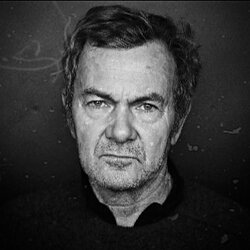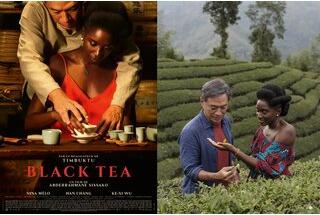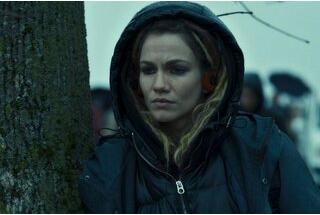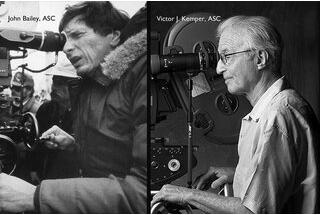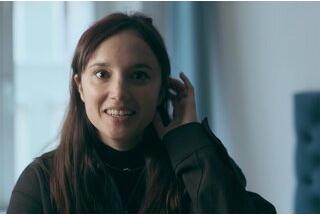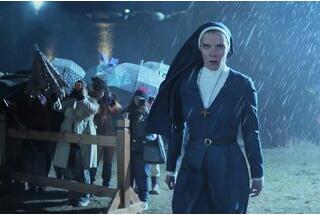Interview with Yves Cape, AFC, SBC
About his work on "Persecution" by Patrice Chereau and "White Material" by Claire DenisEric Guichard: Yves Cape, hello. Two films that you’ve photographed were in competition at the 2009 Venice Film Festival. Let’s talk about both films, but perhaps we can begin by talking about the one by Patrice Chereau.
You spoke to me about doing tests with the Red, but you ended up shooting in 35 mm. When did you decide to do these tests in Red and why the final choice of 35 mm?
}}Yves Cape: During one of my first encounters with Patrice Chereau, he discussed the possibility of making a film in HD without being specific. He wanted to know if I was up for it. Without hesitation, my answer was yes. Once it was established that I was doing the film, Patrice told me his idea: he had documented one of his plays with the Red and had been surprised by the quality. He wanted to explore that option to see what it could bring from an aesthetic and an economic standpoint.
Moreover, Patrice did not want to hear about limiting film footage. On the set, Patrice has a system of working with actors that is in constant evolution; you know where the scene starts, but not where it stops, which means shooting a lot to get what he wants. Our budget was fairly tight, 4 million Euros with a big cast: Charlotte Gainsbourg, Romain Duris, and Jean-Hughes Anglade, among others. We could not afford the 2 000 meters per day in 4 Perf that we needed.
I met with Raphael Bauche, with whom Patrice had shot his play. Raphael knows the Red and its workflow. I also met Frederic Savoir of Amazing Digital Studios with whom Move Movie, the production company, is used to working. Frederic knows the different HD cameras and workflows that they entail. Together, we decided to test the Red, the D21 in 4:4:4 spherical and raw anamorphic modes, and Super 16.
All of these cameras were in the 2.40:1 wide-screen format we had chosen for the film. I insisted at this point to also test in 2 Perf, but production did not think it made sense budget-wise.
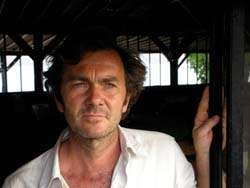
We did 3 days of testing. One day where we assembled all the equipment at TSF, and we looked at the different hand-held configurations, the recording systems, accessories, monitors, wireless video, and the roles needed in each configuration, etc.. One day testing techniques on stage and outdoor: exposure tests, contrast, etc.. And one day on the main location (a loft in Montreuil) with two actors, Patrice, a dolly and some lighting. This day was extremely interesting.
Patrice was confronted with the space of his location, and the staging he could do there. We decided not to take account of the technical problems of each format in order to compare them efficiently. We did the same shots in each format. We shot by day and by night.
These tests taught us several things immediately. The D21 in hand-held with motors for focus and aperture, Venon magazines, etc: 24 kilos! The D21 raw requires a cart with hard disk, etc.. In 4:4:4 mode, it is already more reasonable, just an HDCAM SR VTR!
Red: 19 kilos, with an ergonomics that did not please me at all. Moreover, I could not see operating without an optical viewfinder and certainly not with an electronic viewfinder of such poor quality.
In short, all this distanced us considerably from what Patrice wanted: a mobile camera, with swooping technique! Only the Super 16 gave us this opportunity. Also, at this time, the D21 was just arriving at TSF and I had no desire to turn the set into an experimental lab. All these tests were timed with Frederic Savoir at Amazing Digital Studios. As everyone knows, the final result varies considerably with the workflow used.
At that time, no one had graded the D21 in Paris and they were just beginning with film-outs of the Red (a few tests existed, but no finished film). The results we obtained were related to the workflow used at that time at Amazing. Since then, the workflows for the Red and D21 have evolved. For our tests, we quickly realized that the D21 was timed very easily, while the RED was more difficult to work with, especially to get natural skin tones. We had no problems with 16mm.
Technically, the D21 has an exposure latitude not far from 35mm film (plus or minus 9 stops), the Red has less. In the blacks and the whites, the D21 creates a texture close to what we know in 35 mm, which is far from the case with the Red.
A selection of these tests was filmed-out to 35 mm at Éclair lab. The images from the D21 were very accurate: correct skin tones, a wide margin before getting to overexposure and when you get there, an interesting texture. Same thing in underexposure, a very beautiful texture and a very good general rendering of color.
The images from the Red were scary! Not much margin for over-exposure, little room for under-exposure, incorrect skin tones, a maddening rendition of color, but still a very beautiful texture! After these two very smooth cameras, the Super 16 revealed its grainy flaws especially at ISO 400.
Given that 8 weeks of hand-held with the D21 was unthinkable, we had no solution handy! After discussion, Patrice took the responsibility of saying that he would make the necessary savings to shoot 2.40 in the 35 mm 2 Perf format.
Were you using the entire negative area?
YC: The surface of the 2.35:1 image in the 2 perf area is 30% less than the size of a 2.35 Super 35 image in 3 or 4 perf. Which is not insignificant. It was not disturbing for this film, as I was trying to make a dirty image, or, to be more exact, trying to never be clean. So this extra grain went in the direction I was going. I shot everything in Kodak 500T 5219 so as to always be ready for anything.
You abandoned super 16?
YC: Patrice thinks it’s too dirty, with not enough resolution, and also this difficulty that one can have in 16 mm (if you respect the physical distances between actor and camera that Patrice likes) of creating different shots with the focus. 16mm, by virtue of its equipment and the size of the negative, tends to have more depth of field. To overcome this, you have to cheat the camera distance to the actors, and work with longer focal lengths. Patrice obviously doesn’t like this, he wants an exact distance to his characters, he puts the camera at a human distance. This is one of the few advantages of the Red, it has, by the size of its sensor, very shallow depth of field, which defines shots and therefore the image.
It’s also cheap!
YC: The RED has an advantage in a certain kind of economy: the camera doesn’t cost too much, it is possible to set up your own editing system and do the timing yourself with Final Cut Pro and Color. In the US, many independent films are made this way.
I think the workflow is more established now. Nevertheless the sensor and the signal compression are what they are.
It’s another way of making films.
YC: Film has become expensive compared to other options, Kodak will have to adapt itself, otherwise... Arri, with its new camera for 2010, is definitively making the step towards HD.
In 4 Perf, would you have been forced to do a photochemical finish, or would you have also been able to do a DI?
YC: With our budget, we had no choice: in 4 Perf, we would have done traditional photochemical timing, but in 2 Perf, it was DI. For the moment, you cannot do an optical blow-up. I hope it will happen soon. DI is expensive, 2 Perf with traditional timing could be be interesting.
Was shooting in Super 35 and doing a DI important to you to do the project as Patrice defined it ?
YC: It’s a film that did not need DI. But it’s still a fantastic tool. We spent three weeks ago with Isabelle Julien. Patrice (he’s not the only one!) sees a difference compared to traditional photochemical that bothers him. Even if he can’t put his finger on exactly what is bothering him.
In flesh tones in low light, in color, you see something different. On the other hand, DI does allow you to do things to the contrast, the colors, to certain areas in the frame. I noticed that in underexposure, with low contrast images, you get a better result directly from the negative. You should therefore light more! And the flesh tones especially bother me, a lot. Whether it be in HD or in DI, there’s often something strange about flesh tones.
This is the 2nd movie that I posted totally digitally (after Hadewijch by Bruno Dumont), and each time I discover new problems.
Let’s return to collaboration. With Claire Denis and Patrice Chereau, who have had strong collaborations, one with Agnès Godard and the other with Eric Gautier, how do you manage the meetings? I’m not speaking of the “casting” stage, but afterwards, once you’re hired.
YC: Claire is like Patrice, once they find themselves facing another DP, it interests them, they don’t look back, they go forward, they learn the flaws and qualities of their new DP. And they use them.
When we returned from Africa, I screened the dailies of the film with Claire. I was very disapointed: the frame was dry, hard, violent, the opposite of Agnes, who has a wonderful flow to her frame. We barely paused between reels, and I was sinking deeper and deeper into my chair! At the end, Claire got up and said, "Oh, Yves, I love this brusque way you have of manipulating the camera!"
You have to forget comparisons pretty quickly. I don’t necessarily always frame the same way. It is useless to compare, it’s just something else.
Both directors are very close to their DP on the set. It’s very exciting, there is a huge collaboration between the actors, director and cameraman. Like I have rarely experienced.
To talk about this kind of director, I could make a comparison with Bruno Dumont, who is quite the opposite: he works the camera, its set-up, and on the other hand, he works with the actors, and these are two things that he will confront.
Here, on the contrary these are things that go together, so it was very different for me, with a lot of anxiety at first. Both directors are extremely generous with their cinematographer. There is never any criticism from them, you go forward, you don’t blame anyone, it is useless to say: "we didn’t do this well", you go forward. They see it as a whole, a general osmosis to be created.
Claire made me do things I never dared to do, light the night with just one Chinese lantern, for example. She pushed me and finally the result is great. These are people who manage to get the best from us, to shake us in our habits. It was the same operating with Patrice, I would never have dared to go so far with the shots. Patrice’s film is a real mixture of handheld camera and dollies. The first day, when we started setting up the dolly, my key grip and I weren’t very proud - we started almost together. It was really intimidating.
In the end, Patrice’s film resembles a film by Patrice and Claire’s film a film of Claire ... That puts us back in our place!
Patrice, lately, has been used to films that, without being wealthy, had fairly important budgets, where his margin for maneuver was pretty wide important. Did finding himself in a production where every Euro was counted allow him to challenge himself, or was it the opposite?
YC: Patrice’s latest film didn’t have very big budgets. Changing producer has certainly produced some positive energy in him. He asked for ten hour days on set, he shot the film in 42 days.
I found him very respectful of everyone, very nice on the set, you need courage to oppose him, but it’s worth it because that’s when it becomes fantastic. But beware, because he goes very fast, he is always already on the next idea. The days are very intense, exhausting but so exciting!
Patrice did something pretty incredible. In the scenario of Persecution, there are some dialogue sequences that must run between 5 and 10 pages, therefore to be shot over several days. Patrice has no problem stopping the sequence in the middle and continuing or starting again the next day (to re-do a shot a week later!).
For the actors, it is an incredible exercise to dive back in and for a DP, it is sometimes very dangerous. Fortunately Eric had warned me, so I took my little notebook! For Patrice, it’s normal that that we be able to redo a scene, it’s our job, just as it is the actors’ job.
Because he sees the assembly and he wants to add to it? Or is it in his head?
YC: No, it’s in his head, that is to say, suddenly, he had asked an actor to smile and thinks that, at this point, he shouldn’t smile. Or else he would like to have the possibility of a smile in the editing, doesn’t have it, and wants to get it…
Both directors share a particularity, their approach to faces: an almost carnal choreography, both for Patrice Chereau and Claire Denis.
Do you find other similarities between the two directors?
YC: No, very little. They have totally different ways of working. I hadn’t thought about it before, but it is true that they are make portraits. But they have totally different approaches.
Claire is very instinctive, what she likes is to work on the present moment, she doesn’t like to prepare or rehearse too much, either technically or with actors. It’s very instinctive, she tries to grasp what is happening.
Patrice is the opposite. It’s all very thought out and prepared. He hopes in this way to have more freedom when shooting. I attended the read-throughs between Jean-Hughes Anglade and Romain Duris, and it was exciting. They are two actors who are very opposed in their way of working. Jean-Hughes Anglade is very anxious, attentive to every comma, every careful word meaning and thus raises many questions to Patrice. Romain Duris is completely instinctive, he plays on instinct and depending on what Patrice says, offers something else.
Patrice comes with a very precise idea of what he will do, and then he likes if that idea is shattered by the actors, by the camera.
These are really two different ways of working. These two films do have in common that they follow the main character from the beginning to the end (Romain Duris in Persecution and Isabelle Huppert in White Material).
This frame and the following are excerpts from the film Persecution by Patrice Chereau, photographed by Yves Cape
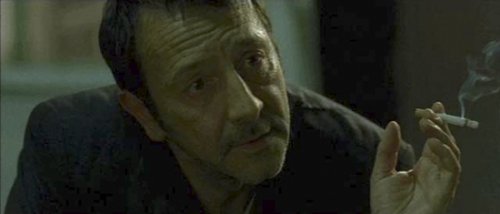
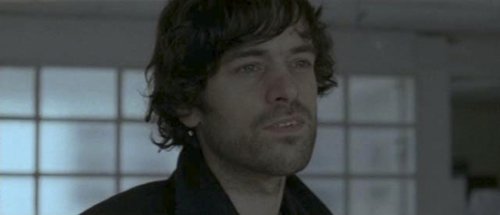
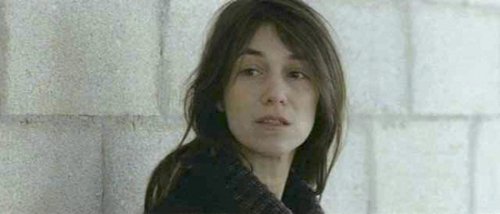
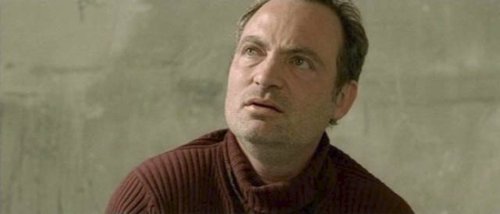
In watching Patrice once, and knowing a little about Claire Denis’ films, I felt that Patrice is more about choreography in three dimensions, while Claire is more about flatness in two dimensions.
YC: Claire likes what is beautiful, everything starts from there. In a scene, she will immediately pick out what is beautiful: it can be light, an actor’s look, a prop, a set. This can completely disrupt the staging.
Say the scene is written with a person lying in bed, if suddenly she sees the actor drink his coffee standing at the bar in the morning and if she finds it beautiful, the scene goes from there. It can be very distressing for everyone. So she will look at what is the most beautiful way and go there. And the staging will flow from that. In fact, we can say that it is almost a single dimension: the face in its environment.
With Patrice, it’s a true choreography. Patrice loves that people speak, that they move, that there are accidents. They try to recreate the natural. Some of the dailies of a scene set up with a lot of dialogues can resemble a documentary! Patrice attempts to bring everybody to this. He would like for the technology to allow him the freedom to get to this. This is not why some set-ups are involved, but if they are, is to allow for this.
You spoke of dailies. These days there is a fairly disastrous problem with crews following their own work less and less. How did this go with your two different experiences, with Patrice and Claire?
YC: With Claire, it’s simple because she does not see the dailies, it demoralizes her! So we were in Africa, Claire not looking at dailies, and the producer seeing them in Paris. From time to time I saw dailies on DVD and I had still images sent to me over the internet by the lab. Claire does not go backwards, she advances. It’s the opposite of Patrice, she doesn’t want to start over.
Patrice is different. He sees all the dailies, in their entirety, with synch sound. From the beep until the end. He also looks at the mini DV recorded by the video assist, hence the reshoots the following day.
When you say he saw everything, did he see it with you?
YC: For practical reasons, Patrice sees the synchronized dailies made by the editors on DVD at his house on his TV. It’s good enough for him to analyze what we did. The image quality of these DVDs is very bad, so I would look at the dailies twice! Once in mini DV, with better quality but without sound, and once on DVD for the acting. We often used these Mini DVs for reshoots or to add a sequence: they allowed us to check the lighting matches in addition to our notes.
I have not yet found a good solution for the dailies. Timed dailies are mandatory now, not only because they are seen by the director and editor for months, but they are also sometimes used for promo reels, for co-producers, etc.. But timed dailies can be misleading, the colorists are rarely those who will time the film, they are under a lot of pressure, from the lab and from us. They therefore tend to flatter the image and you can’t necessarily get the same thing later. Hence unnecessary discussions during DI with the director and colorist.
It reminds me of a remark by Olivier Chiavassa at Eclair when I was an assistant to Michel Abramowicz: the dailies were still "one light". To help DPs, Eclair had started doing timed dailies. I remember an irate Oliver saying: "But this is crap what we did for you, we should return to "one light ", because now when you make mistakes, you won’t see them. You can’t analyze your footage and it’s a disaster." Now with video dailies, we have the same problem. We also know that "one light" video dailies don’t work either. The solution is hard to find.
In both of these projects, did the editors leave the image alone or did they touch it up on the Avid?
YC: Not without telling me. If they do it is often for questions of chronology and I always ask to have lab test done to see if it works.
Let’s talk about your collaboration with Claire Denis, which was new for you. You’ve shot in Africa, how did the prep go?
YC: White Material happens on a coffee plantation in Africa, Claire did scouting in different African countries, and we finally shot in Cameroon. It’s a country that Claire knows well and she likes a lot: she lived there as a child with her family. That’s where she filmed her first movie, Chocolate, and she knows many people there.
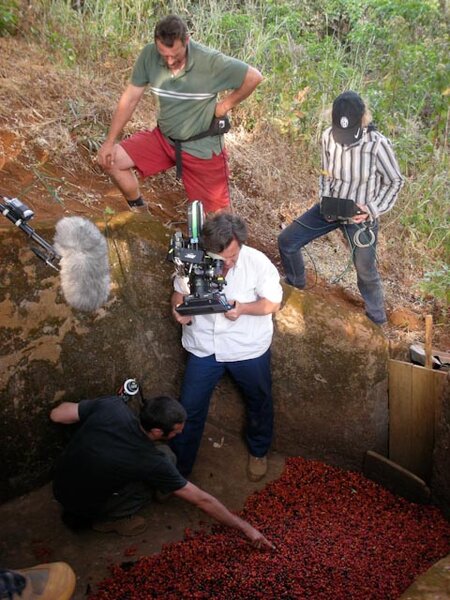
The film was to shoot during the coffee harvest. We brought in all the heads of departments, and had technicians on site that complemented ours. It went very well. I have done a lot of films abroad and I love it. When you leave home, your habits are disrupted. It forces us to be more resourceful. Here we have a strong tendency to be over-assisted and to take advantage of this!
As far as lighting, I had two problems to resolve in Cameroon. Bright white skies that make an extremely soft light, which tends to make the image a little flat. Or conversely, a high sun very early in the day until very late, which therefore rarely treats faces well. With Claire, we were always trying to find solutions: either in terms of work schedule or in the sets or with the framing.
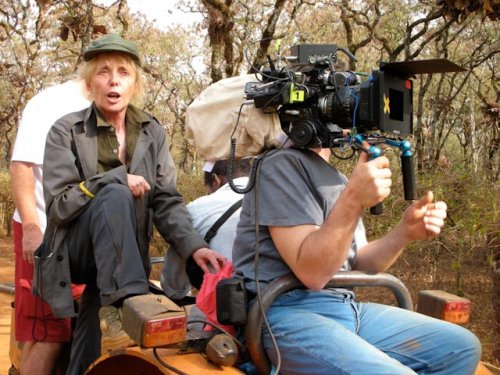
Did you choose flexible hours?
YC: It’s complicated, because in Cameroon to shoot in good light, you would have to shoot from 8 to 10 AM and 4 to 6 PM!
Claire has made several films in Africa, has used black actors several times. Did you look at films together, hers or others? As she discovered a new DP, she was on new ground...
YC: She was starting from scratch. She told me what she didn’t like, not so much with references, as with words.
I watched many movies shot in Africa. Claire didn’t want the usual yellowish image for daytime. She wanted a neutral image, very bright, slightly magenta, which also made Isabelle Huppert beautiful: her pale skin came out along with her freckles and red hair. We made a film that is very bright, sometimes dazzlingly so in the daytime scenes.
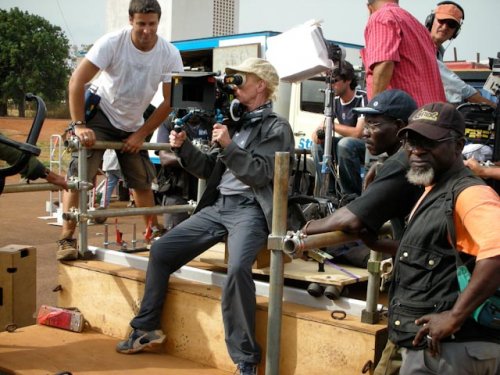
For Claire’s film, is the timing in photochemical or...
YC: Yes, Claire hates digital. She did a DI for 35 Rums and I think she does not want to hear about it any more. At least for now.
So what film did you choose?
YC: During prep, we went to Cameroon for ten days to see the locations, meet people, shoot footage of coffee in that season and do film tests. Unfortunately all of the test we did were exposed by Air France’s x-ray! We managed to save some shots that are in the film.
The 5245 tests were magnificent. It has a very neutral aspect, very sharp, which pleased Claire. The problem is that with Isabelle Huppert I could not afford to work in 45 because of its contrast. It would have forced me to put in place a lighting infrastructure that I couldn’t have. I used the 45 just for landscapes and for certain sequences. We shot the film mostly with the 200, and 500 for the night.
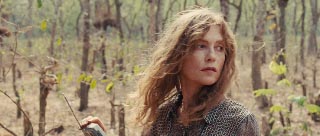



I rarely filter, whether it be in Claire or Patrice’s film; in the future, I will diffuse a bit more. When one wants to shoot in all directions and quickly, it’s true that diffusing the image a little helps when you get to the color timing.
Especially as there now exists a very discreet range of filters...
YC: I usually filter close-ups of faces a little. Claire doesn’t like it. You can’t transform the face of an actor, you can’t betray him, in a way. It’s the same for color timing: if a shot is not beautiful, you shouldn’t try to fiddle with it in timing. If it’s not beautiful, it’s not beautiful.
Was this the first time that Isabelle Huppert worked with Claire Denis?
YC: They had a common desire to work together. Claire wrote with Marie Ndiaye. Marie Ndiaye did some preliminary scouts in Africa with Claire to feel and see the coffee plantations run by whites. The script is very beautiful.
Isabelle, knowing Claire, knew that her image would be put in danger…
YC: Isabelle soon realized that Claire would not betray her. In the film, there are two or three moments when the lighting really isn’t nice on Isabelle, things that Claire could not remove in the editing, but she was very careful about that.
I have great admiration for Isabelle Huppert. Claire asked her for amazing things, Isabelle always trusted her, and with regard to me, she was fantastic. She sensed that my involvement with Claire was total and therefore that I also cared about her image, and that we did everything to render her strength and determination, which is one of the subjects of the film.
Something quite amazing happened to us on the film. All our equipment — except for the camera equipment which came with us by plane— all the rest, the grip, lighting, makeup, it all came by boat and was stuck in the port of Douala for three weeks. So the production wanted to postpone the shooting. Claire, because of the seasons, did not, and we decided to start shooting. Claire spoke with Isabelle, who agreed.




So we arranged the work schedule, starting with exteriors rather than nights, of course. We built reflectors with sheets from our rooms on wooden frames! It gave a real tempo to the film. When the equipment arrived, we never used the dolly, we used lights outside on very rare occasions, and as we were travelling light, we used very little for the nights. We worked like that and it worked out very well.
We have had the naiveté to ask these questions without having seen the films, but perhaps we will come back to your work after seeing them.
Thank you Yves.
Translated by Benjamin B
 En
En
 Fr
Fr